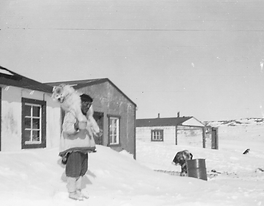
ANGULALIK: INUINNAQ TRADER
Angulalik was born into an Ahiarmiut family around 1898 in the vicinity of the Ellice River (Kuunnuaq) on the Queen Maud Gulf. His father was Oakoak and mother Okalitaaknahik. On his father’s side his grandfather was Illiviujaq and grandmother Koihok. Angulalik first appears in documentary sources in 1923 when he was recorded to be living in Kiillingujaq (Kent Peninsula) with his wives Koloahok and Kuptana, a daughter Kaitok (Rowena), and an adopted son Oakoak (George). Angulalik later adopted Nakoyak (Jimmy) from Topilikon and Kaitak.
At the time of Knud Rasmussen’s visit, Angulalik was living close to the HBC trading post at Kent Peninsula. It had been the most eastern post in the Kitikmeot since its inception in 1920, until the establishment of an even more remote HBC post at Simpson Strait in 1923 by Peter Norberg. It was at the HBC post at Kent Peninsula that Angulalik would have first had extensive contact with post manager Hugh Clarke. Clarke had close relations with the Inuinnait of the area, becoming fluent in Inuinnaqtun, and fathering a son and daughter with a woman from the area. The son died, but the daughter born in 1922, was thought to have survived to adulthood.
ANGULALIK:
INUINNAQ FUR TRADER
_Angulalik%2C_Kolaohok_(holding_Do.png)
(l to r) Angulalik, Kolaohok (holding Donald Ayalik) and Kuptana. (Northwest Territories Archives / N- 1986-002: 0011)
The relationship between Clarke and Angulalik was very important to Angulalik’s education in the operation of a trading post. Angulalik worked with Clarke at the Kent Peninsula post and was taught much about the fur trading business according to Clarke's late former wife Marjory Robertson. Clarke left the north and the HBC in the summer of 1924, and married Marjory Robertson in 1925 in Vancouver, British Columbia. He was soon engaged by C.T. Pederson of Canalaska to build the supply ship Nigalik and Clarke sailed north with the new ship in 1926. That same year he and George Porter established the Canalaska Trading Post at Perry River.
Canalaska’s choice of Perry River as a location for its trading post is very likely to be a product of Clarke’s close relationship with Angulalik and the Ahiarmiut. According to his former wife, he thought very highly of the Ahiarmiut, and understood the Perry River area to be a rich fox trapping area. His knowledge of the resources of the Perry River area must have come from the Ahiarmiut and perhaps Angulalik in particular.
What is certain is that Angulalik became an important ally and was key to the success of the Canalaska post. Angulalik’s leadership of the local Ahiarmiut or Kuugjuarmiut ensured their fidelity to Clarke’s post. This was key, as an HBC post run by J. Livingston was also built in 1926, and was located just 7 miles down river. The relationship of reciprocity between Clarke and Angulalik is evident in the fact that Clarke built a small house for Angulalik at the Canalaska post.
Angulalik was closely associated with the post at Perry River, and was occasionally employed to assist Clarke and Porter. It was during the years 1926 to 1928 that Angulalik continued the education in the fur trade he had begun with Clarke at Kent Peninsula. When the Canalaska and HBC posts at Perry River were forced to shut down operations in 1928 by Government order, the conditions were opportune for Angulalik to enter the fur trade as an independent trader. Through a combination of his own initiative, and with the encouragement and support of Clarke, arrangements were made for Angulalik to run an independent trading post supplied by Canalaska.







